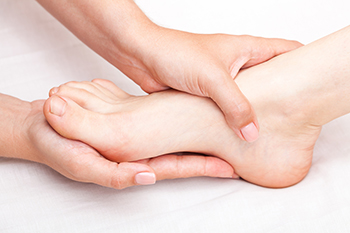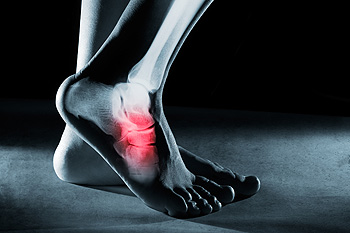Connect With Us
Blog
Items filtered by date: December 2023
Do You Suffer From Painful Feet?
How Podiatrists Can Detect and Treat Running Injuries

Runners visit podiatrists for initial consultations on lower extremity injuries, knowing that identifying the cause is as important as addressing the symptoms. As a practitioner, gaining a runner's trust is essential, which involves showing understanding of their training and equipment, plus being attentive to their detailed injury accounts. A thorough examination is critical, including both static biomechanical and dynamic gait assessments. This is ideally done with the runner in their usual footwear and attire for complete lower extremity visibility. Common injuries among runners can include plantar fasciitis, Achilles tendon injuries, and stress fractures. Regardless of the injury, the aim of treating runners is to ensure their swift yet secure comeback to running. Important to treatment is effective communication and aligning expectations regarding outcomes which are key to supporting patients and helping them stay balanced through challenging periods of recovery. If you are a runner and have experienced a foot or ankle injury, it is suggested that you make an appointment with a podiatrist who can offer appropriate injury prevention techniques.
Exercising your feet regularly with the proper foot wear is a great way to prevent injuries. If you have any concerns about your feet, contact Dr. Royall of Mountain View Foot & Ankle Clinic. Our doctor will treat your foot and ankle needs.
How to Prevent Running Injuries
Many common running injuries are caused by overuse and overtraining. When the back of the kneecap starts wearing out and starts causing pain in your knee, this is commonly referred to as runner’s knee. Runner’s knee is a decrease in strength in your quadriceps and can occur if you’re not wearing properly fitted or supporting shoes. To prevent runner’s knee, focusing on hip strengthening is a good idea, as well as strengthening your quads to keep the kneecaps aligned.
What Are Some Causes of Running Injuries?
- One cause of a common running injury is called iliotibial band syndrome.
- Plantar fasciitis is also another common injury.
- Stress fractures can occur from overtraining, lack of calcium, or even your running style.
Best Ways to Prevent Running Injuries
- Wear footwear that fits properly and suits your running needs.
- Running shoes are the only protective gear that runners have to safeguard them from injury.
- Make a training schedule. Adding strengthening exercises as well as regular stretching can help keep you strong and limber and can lessen the possibility of injuries.
- Stretching keeps muscles limber; this will help you gain better flexibility.
If you have any questions please feel free to contact our office located in Lehi, UT . We offer the newest diagnostic and treatment technologies for all your foot and ankle needs.
Common Advice From Podiatrists

Taking an average of 8,000 steps a day, it is essential to give your feet the care they deserve. Podiatrists emphasize the importance of foot health, offering useful advice. One key recommendation is to refrain from walking barefoot in public showers, as they are hotspots for athlete's foot-causing fungus. Wearing protective footwear such as flip-flops or water shoes is advised. Extra attention should be paid to drying the feet, particularly between toes. The condition of your feet can be indicative of overall health. For instance, changes like the disappearance of toe hair or alterations in skin texture may signal peripheral arterial disease, or PAD, which can suggest broader cardiovascular issues. Dry skin and non-healing ulcers could point to undiagnosed diabetes. Choosing the right footwear is critical. Pointy pumps, for example, can lead to bunions and other painful conditions. Shoes with a wide toe box and heels under two inches are recommended. Additionally, the length of your toes matters. If your second toe is longer than your first, it can lead to various foot problems, including bunions and back issues. This condition, known as Morton's toe, requires wearing appropriate footwear to mitigate problems. Toenail fungus is another common issue, often indicated by discolored or brittle nails. Keeping the feet dry and changing sweaty socks frequently may help to avoid fungus. If you would like to obtain additional information about good foot care,it is suggested that you schedule an appointment with a podiatrist who can provide you with useful advice.
If you are experiencing pain in the feet or ankles, don’t join the stubborn majority refusing treatment. Feel free to contact Dr. Royall from Mountain View Foot & Ankle Clinic. Our doctor can provide the care you need to keep you pain-free and on your feet.
What Is a Podiatrist?
Someone would seek the care of a podiatrist if they have suffered a foot injury or have common foot ailments such as heal spurs, bunions, arch problems, deformities, ingrown toenails, corns, foot and ankle problems, etc.
Podiatric Treatment
A podiatrist will treat the problematic areas of the feet, ankle or lower leg by prescribing the following:
- Physical therapy
- Drugs
- Orthotic inserts or soles
- Surgery on lower extremity fractures
A common podiatric procedure a podiatrist will use is a scanner or force plate which will allow the podiatrist to know the designs of orthotics. Patients are then told to follow a series of tasks to complete the treatment. The computer will scan the foot a see which areas show weight distribution and pressure points. The podiatrist will read the analysis and then determine which treatment plans are available.
If you have any questions please feel free to contact our office located in Lehi, UT . We offer the newest diagnostic and treatment technologies for all your foot and ankle needs.
Causes and Risk Factors of Foot Stress Fractures

Foot stress fractures, tiny cracks in the bones, can emerge from a myriad of factors that subject the feet to repetitive stress and strain. One primary cause is overuse, where excessive or sudden increases in physical activity like running or prolonged standing surpass the bones' capacity for repair. Wearing inadequate footwear or worn-out shoes lacking proper support amplifies the risk, as they fail to absorb shock adequately. Biomechanical factors, like abnormal foot structure or gait patterns, contribute to uneven weight distribution, placing specific areas under heightened stress. Insufficient conditioning and muscle fatigue diminish the ability of muscles to absorb impact, transferring excess force to the bones. Additionally, nutritional deficiencies, particularly in calcium and vitamin D, compromise bone strength, elevating the susceptibility to stress fractures. By wearing proper footwear, adopting a gradual training progression, and supplying nutritional support, individuals can fortify their foot health and reduce the likelihood of encountering the discomfort associated with stress fractures. If you have developed a foot stress fracture, it is suggested that you are under the care of a podiatrist who can offer you the treatment option that is right for you.
Stress fractures occur when there is a tiny crack within a bone. To learn more, contact Dr. Royall from Mountain View Foot & Ankle Clinic. Our doctor can provide the care you need to keep you pain free and on your feet.
How Are They Caused?
Stress fractures are the result of repetitive force being placed on the bone. Since the lower leg and feet often carry most of the body’s weight, stress fractures are likely to occur in these areas. If you rush into a new exercise, you are more likely to develop a stress fracture since you are starting too much, too soon. Pain resulting from stress fractures may go unnoticed at first, however it may start to worsen over time.
Risk Factors
- Gender – They are more commonly found in women compared to men.
- Foot Problems – People with unusual arches in their feet are more likely to develop stress fractures.
- Certain Sports – Dancers, gymnasts, tennis players, runners, and basketball players are more likely to develop stress fractures.
- Lack of Nutrients – A lack of vitamin D and calcium may weaken the bones and make you more prone to stress fractures
- Weak Bones – Osteoporosis can weaken the bones therefore resulting in stress fractures
Stress fractures do not always heal properly, so it is important that you seek help from a podiatrist if you suspect you may have one. Ignoring your stress fracture may cause it to worsen, and you may develop chronic pain as well as additional fractures.
If you have any questions, please feel free to contact our office located in Lehi, UT . We offer the newest diagnostic and treatment technologies for all your foot care needs.
What to Expect From Hammertoe Surgery

Hammertoe surgery is a procedure designed to address the deformities associated with hammertoe, a condition in which one or more toe joints become bent. Before the surgery, your podiatrist will conduct a thorough evaluation, including a physical examination, and possibly perform an X-ray that can assess the extent of the deformity and determine the best course of action. They will also have a discussion with you about the procedure, its potential risks, benefits, and alternative treatments. Depending on the complexity of your case and your preferences, hammertoe surgery can be performed under local anesthesia with or without sedation, or under general anesthesia. During the surgery, your surgeon will make incisions, reposition the affected toe joint, and may remove a small piece of bone or tendon. The toe will then be straightened and secured in its corrected position, often using pins, wires, or screws. Following the surgery, you will likely wear a special shoe or cast to protect the toe. Initially, you may experience swelling and discomfort, but these symptoms can gradually improve over time. If you have a hammertoe that is causing you pain, it is suggested that you make an appointment with a podiatrist to determine whether surgery can help improve your comfort and foot function.
Foot surgery is sometimes necessary to treat a foot ailment. To learn more, contact Dr. Royall of Mountain View Foot & Ankle Clinic. Our doctor will assist you with all of your foot and ankle needs.
When Is Surgery Necessary?
Foot and ankle surgery is generally reserved for cases in which less invasive, conservative procedures have failed to alleviate the problem. Some of the cases in which surgery may be necessary include:
- Removing foot deformities like bunions and bone spurs
- Severe arthritis that has caused bone issues
- Cosmetic reconstruction
What Types of Surgery Are There?
The type of surgery you receive will depend on the nature of the problem you have. Some of the possible surgeries include:
- Bunionectomy for painful bunions
- Surgical fusion for realignment of bones
- Neuropathy decompression surgery to treat nerve damage
Benefits of Surgery
Although surgery is usually a last resort, it can provide more complete pain relief compared to non-surgical methods and may allow you to finally resume full activity.
Surgical techniques have also become increasingly sophisticated. Techniques like endoscopic surgery allow for smaller incisions and faster recovery times.
If you have any questions please feel free to contact our office located in Lehi, UT . We offer the newest diagnostic and treatment technologies for all your foot and ankle needs.
Blog Archives
- April 2025
- March 2025
- February 2025
- January 2025
- December 2024
- November 2024
- October 2024
- September 2024
- August 2024
- July 2024
- June 2024
- May 2024
- April 2024
- March 2024
- February 2024
- January 2024
- December 2023
- November 2023
- October 2023
- September 2023
- August 2023
- July 2023
- June 2023
- May 2023
- April 2023
- March 2023
- February 2023
- January 2023
- December 2022
- November 2022
- October 2022
- September 2022
- August 2022
- July 2022
- June 2022
- May 2022
- April 2022
- March 2022
- February 2022
- January 2022
- December 2021
- November 2021
- October 2021
- September 2021
- August 2021
- July 2021
- June 2021
- May 2021
- April 2021
- March 2021
- February 2021
- January 2021
- December 2020
- November 2020
- October 2020

